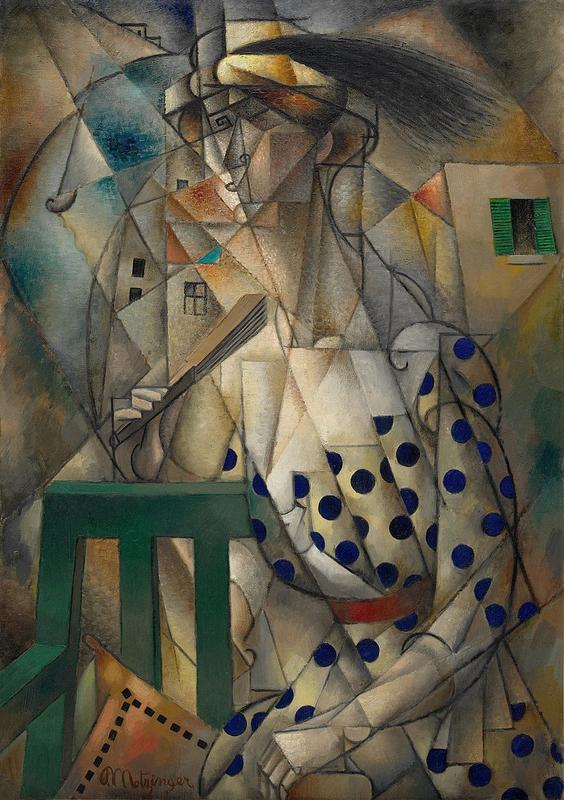More about Woman with a Fan

Contributor
Jean Metzinger's Femme à l'Éventail served as a cubist warning shot during its majestic debut at le Salon d'Automne 1912.
The artwork thumbed its oil-painted nose at its many political and moral opponents, evoking similar reactions to a hip-hop record in the early '90's. For the French art scene, the creative scandal du jour was Cubism.
The Femme à l'Éventail hung defiantly at le Salon, at the Grand Palais on the river Seine, from October 1-8, 1912. The publisher Paul Gallimard organized no fewer than 52 books to accompany the exhibition, and the poster was designed by the brilliant Pierre Bonnard. In the enormously controversial "cubist room" also hung Metzinger's Danseuse (Dancer in a Café), which now hangs at the Albright-Knox Art Gallery, La Plume Jaune (The Yellow Feather), and Paysage (Landscape). Art critics Louis Vauxcelles and other adversaries "would begin by saying: 'there is no need to devote much space to the Cubists, who are utterly without importance,'" writes the blogger Peter Brooke, "and then they furiously gave them seven columns out of the ten that were taken up, at that time, by the Salon." As it often does, the controversy spurred public interest in the very art form the critics were railing against.
In a fascinating twist, art historian Lynn Catterson brilliantly reveals that the strong reacion against cubism may have had a strange source. At the fin de siècle (turn of the century), freewheelin' France was suffering from a brutal phase of sexually transmitted diseases among its citizens, and the fear was that cubism, by geometrically decomposing the human body in order to transcend Euclidean mathematics, was also somehow celebrating the physical decomposition of people's bodies due to STDs.
It's not our habit to discuss STDs in terms of math, or vice versa, but the Euclidean model is the one that schoolchildren learn, in which spacetime is flat, and physical things relate to one another in a linear, meat and potatoes, one foot in front of the other kind of way. By the Euclidean model, painting is a kind of footnote to objective reality. Non-Euclidean geometry, on the other hand, saw spacetime as curved, which threw everyone, especially mathematicians, for a loop. In a painting sense, Pablo Picasso, Georges Braque, and Metzinger's non-Euclidean aspirations made human bodies look bizarre and lacking in structural integrity. One later mathematician, Mandelbrot, would develop an idea of "fractional dimension" in order to describe fractal, iterative patterns. In fact, math is a central ingredient in the first book on cubism, published by Metzinger and Albert Gleizes, simultaneous with the release of Femme à l'Éventail.
For a certain period, before WWII, this work belonged to the gallery owner Léonce Rosenberg. In 1938, the Guggenheim Museum purchased this work for its founding collection. According to photographic documentation, at le Salon d'Automne 1912 this work hung in André Mare's Le Salon Bourgeois, a room in an amazing, Disney-esque architectural installation, co-designed by Marcel Duchamp's brother, called the Maison Cubiste (Cubist House). It hung alongside Fernand Léger's Le passage à niveau (The Level Crossing) and an unidentified portrait of a woman by Marie Laurencin. The unidentified nature of Laurencin's work shows the disappointing tendency, which persists, to overlook the fundamental contribution of women in the development of the cubism. Laurencin is not nearly as well known as her male peers, despite the fact that Metzinger and Gleizes' cubism book includes more Laurencin paintings than those by Picasso or Braque.
Sources
- Association des professeurs d'archéologie et d'histoire de l'art des universités. Histoire de l'art, Numéros 13 à 16. Paris: Editions C.D.U.-S.E.D.E.S, 1991.
- Brooke, Peter. "The Scandal of Room 41,“ Peter Brooke, http://www.peterbrooke.org/form-and-history/texts/the-epic/scandal.html.
- Catterson, Lynn. Dealing Art on Both Sides of the Atlantic, 1860-1940. Leiden: Brill, 2017.
- Centre de documentation et d'études d'histoire de l'art contemporain. Le Cubisme. Saint-Etienne, Université de Saint-Etienne, 1973.
- "Femme à l'éventail." Ministére de la Culture, Jul. 18, 2019, https://www.pop.culture.gouv.fr/notice/memoire/AP14N01313.
- Forest, Marie-Cécile, and Catherine Ambroselli. George Desvallières et le Salon d'automne. Paris: Somogy, 2003.
- Laurens, Henri. Henri Laurens: rétrospective. Paris: Réunion des musées nationaux, 1992.
Featured Content
Here is what Wikipedia says about Woman with a Fan (Metzinger, 1912)
Woman with a Fan (French: Femme à l'Éventail, also known as The Lady) is an oil painting created in 1912 by the French artist and theorist Jean Metzinger (1883–1956). The painting was exhibited at the Salon d'Automne, 1912, Paris (hung in the decorative arts section inside the Salon Bourgeois of La Maison Cubiste, the Cubist House), and De Moderne Kunstkring, 1912, Amsterdam (L'éventail vert, no. 153). It was also exhibited at the Musée Rath, Geneva, Exposition de cubistes français et d'un groupe d'artistes indépendants, 3–15 June 1913 (L'éventail vert, no. 22). A 1912 photograph of Femme à l'Éventail hanging on a wall inside the Salon Bourgeois was published in The Sun (New York, N.Y.), 10 November 1912. The same photograph was reproduced in The Literary Digest, 30 November 1912.
Metzinger's Cubist contribution to the 1912 Salon d'Automne created a controversy in the Municipal Council of Paris, leading to a debate in the Chambre des Députés about the use of public funds to provide the venue for such 'barbaric' art. The Cubists were defended by the Socialist politician, Marcel Sembat. This painting was realized as Jean Metzinger and Albert Gleizes, in preparation for the Salon de la Section d'Or, published a major defence of Cubism, resulting in the first theoretical essay on the new movement, Du "Cubisme".
A photograph of Femme à l'Éventail appears among the Léonce Rosenberg archives in Paris, but there is no indication of when he acquired the painting. A Rosenberg label on the reverse bears the information "No.25112 J.Metzinger, 1913." By 1918 Rosenberg was buying Metzinger's paintings and may have acquired the picture around this time or soon afterwards.
In 1937 Femme à l'Éventail was exhibited at Musée du Petit Palais, Les Maitres de l'art indépendant, 1895-1937, no. 12 (dated 1912). Mlle. Gamier des Garets probably acquired the painting after the 1937 exhibition. By 1938 Solomon R. Guggenheim Museum had purchased the painting. It was gifted to the museum (gift 38.531) by Guggenheim in 1938 (the year after the formation of the foundation). Metzinger's Femme à l'Éventail forms part of the Founding Collection of the Solomon R. Guggenheim Museum, New York.
Femme à l'Éventail was showcased in an exhibition entitled The Great Upheaval: Masterpieces from the Guggenheim Collection, 1910-1918, from 30 November 2013 to 1 June 2014.
Check out the full Wikipedia article about Woman with a Fan (Metzinger, 1912)












